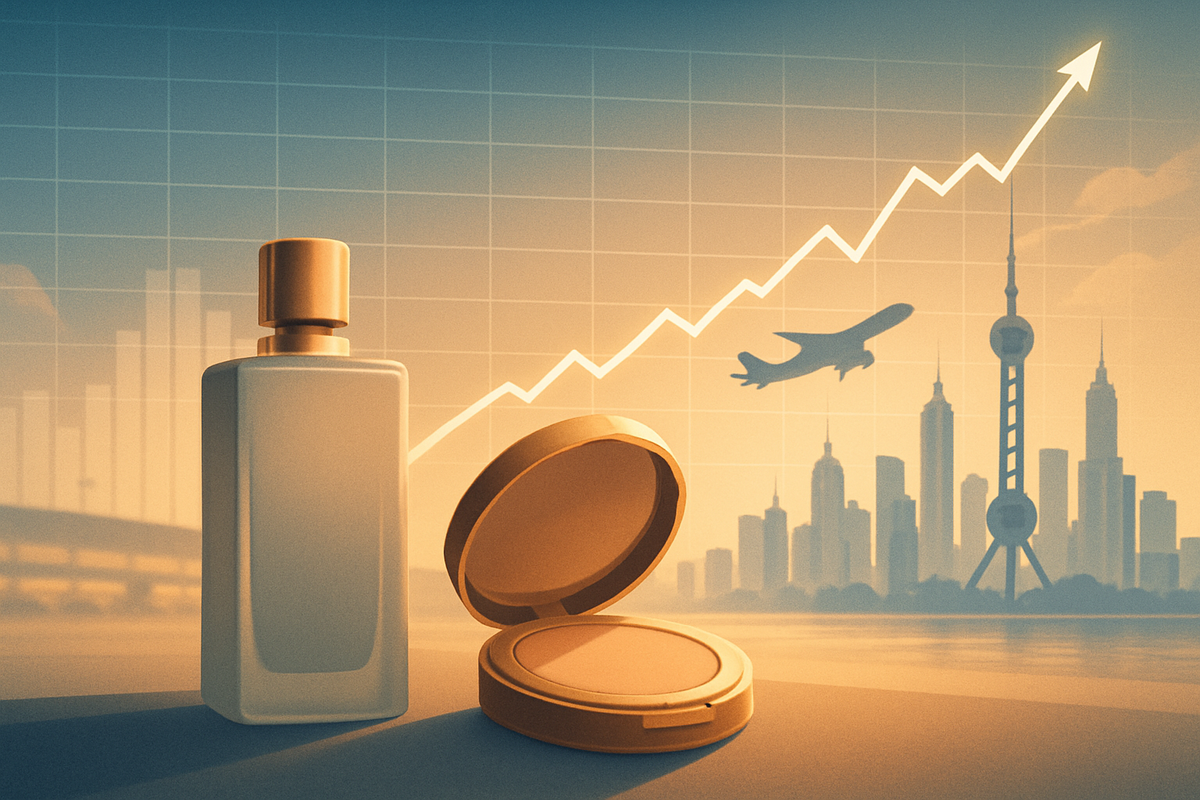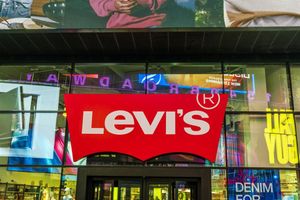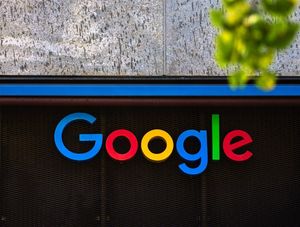
New York, NY – October 13, 2025 – In a significant boost for the prestige beauty sector, Goldman Sachs today upgraded its rating for The Estée Lauder Companies Inc. (NYSE: EL), shifting its stance from a "Neutral" or "Hold" to a confident "Buy." The investment banking giant also substantially raised its price target for the beauty behemoth to $115, a notable jump from its previous $76. This optimistic revision signals a strong belief in Estée Lauder's impending return to robust growth, primarily fueled by a stabilizing Chinese market and a long-awaited recovery in global travel retail.
The upgrade has immediately resonated in the market, with Estée Lauder's shares surging 5% in pre-market trading. This positive momentum comes as a welcome relief after the stock experienced a nearly 7% decline just last Friday, underscoring the profound impact of Goldman Sachs' positive outlook on investor sentiment and the potential for a significant turnaround for one of the world's leading beauty companies.
Detailed Coverage: A Strategic Bet on Recovery and Innovation
Goldman Sachs' decision to elevate Estée Lauder's rating is rooted in a comprehensive analysis pointing to a "fundamental inflection" for the company. Analysts anticipate a return to sales growth as early as the September quarter, paving the way for double-digit earnings before interest and taxes (EBIT) margins in fiscal 2027 and beyond. This projection marks a critical turning point for Estée Lauder, which has navigated a challenging period marked by economic headwinds in key markets and disruptions in its lucrative travel retail segment.
A primary driver behind this newfound optimism is the improving landscape in China, a market pivotal to Estée Lauder's global performance. Goldman Sachs highlighted stabilizing trends, with mainland sales reportedly returning to mid-single-digit growth. This rebound is crucial, given China's status as a powerhouse for luxury goods consumption. Coupled with this, the firm expressed confidence that the worst is behind Estée Lauder in the travel retail sector. This segment, which historically accounted for nearly a third of the company's total sales, faced severe downturns during the global travel restrictions but is now showing tangible signs of recovery, promising a significant revenue stream rejuvenation.
Beyond market recoveries, Goldman Sachs also lauded Estée Lauder's strategic initiatives. The firm pointed to the company's "Beauty Reimagined" vision, a renewed focus on innovation, and a "consumer-first approach" driving faster product development and brand launches. Estée Lauder's expanded presence on digital platforms, including Amazon and TikTok, with 11 brands now available on the e-commerce giant, reflects a successful adaptation to evolving consumer purchasing habits and a diversified channel mix. These efforts, alongside improving U.S. market share trends and the inherent attractiveness of the prestige beauty industry, underpin the bullish outlook from Goldman Sachs.
Potential Winners and Losers in the Prestige Beauty Arena
The upgrade of Estée Lauder (NYSE: EL) by Goldman Sachs, predicated on a robust China rebound and travel retail recovery, signals a potentially lucrative period for the company and could have ripple effects across the global beauty industry. Clearly, Estée Lauder stands as the immediate and primary beneficiary. A stronger performance in China, coupled with the revitalization of travel retail, directly translates to increased sales for its iconic brands like Estée Lauder, La Mer, M·A·C, Clinique, and Jo Malone London. The higher price target and "Buy" rating are likely to attract more institutional and retail investors, potentially driving up its stock price further and improving its access to capital for future growth initiatives.
Other major players in the prestige beauty segment are also poised to benefit from these macroeconomic tailwinds. Companies with a significant presence in China and a strong foothold in travel retail, such as L'Oréal (EPA: OR), the world's largest cosmetics company, and Japanese beauty giant Shiseido (TYO: 4911), could see a similar uplift. L'Oréal, with its diverse portfolio including Lancôme and Giorgio Armani Beauty, and Shiseido, known for brands like Clé de Peau Beauté, are deeply invested in both markets. A rising tide in Chinese consumer spending and international travel is likely to lift all boats in the luxury beauty sector, albeit to varying degrees based on brand strength and market penetration. Even smaller, niche luxury beauty brands that rely on international tourism and duty-free channels might experience a resurgence.
Conversely, companies with less exposure to these recovering segments or those facing intense competition in the revitalized markets might find themselves at a relative disadvantage. While the overall market is expanding, the intense competition within prestige beauty means that market share gains for one often come at the expense of another. Brands that have not adequately invested in their digital presence in China, or those struggling to innovate and capture the evolving preferences of Chinese consumers and global travelers, could lag behind. Furthermore, general retailers and e-commerce platforms that heavily rely on beauty sales in these regions, such as airport duty-free operators, are also indirect beneficiaries of this trend, as increased passenger traffic and spending directly boost their revenues.
Wider Significance: Reshaping Global Beauty and Retail Dynamics
Goldman Sachs' upgrade of Estée Lauder (NYSE: EL) transcends a mere stock recommendation; it underscores a broader narrative of recovery and recalibration within the global luxury and beauty industries. This event fits squarely into the burgeoning trend of a post-pandemic resurgence in discretionary spending, particularly within the affluent consumer segments. The anticipated rebound in China is not just about cosmetics; it reflects a wider economic stabilization and renewed consumer confidence in the world's second-largest economy, impacting everything from luxury fashion to automotive. Similarly, the recovery in travel retail signifies a return to normalcy for global tourism, a critical channel for prestige beauty sales that was severely disrupted.
The potential ripple effects of this recovery are extensive. Competitors like L'Oréal (EPA: OR), Shiseido (TYO: 4911), and Coty (NYSE: COTY) will undoubtedly intensify their focus on optimizing their strategies for the Chinese market and travel retail, potentially leading to increased marketing spend, product innovation, and competitive pricing. This could benefit consumers through more diverse offerings and competitive value. Partners in the travel ecosystem, such as airport operators, airlines, and duty-free retailers like Dufry (SIX: DUFN), stand to gain significantly from increased passenger traffic and per-passenger spending. The regulatory landscape in China, particularly regarding import duties and e-commerce regulations, will continue to be a critical factor, and any favorable policy shifts could further accelerate growth.
Historically, the beauty industry has proven remarkably resilient, often demonstrating strength even during economic downturns, albeit with shifts in consumer behavior towards 'affordable luxuries.' The current scenario, however, marks a recovery from an external shock (the pandemic) rather than an internal economic one, suggesting a more robust and sustained rebound as global mobility and economic activity normalize. Comparisons can be drawn to previous periods of strong economic growth in emerging markets, where the rising middle class propelled luxury consumption. The strategic pivots by companies like Estée Lauder towards diversified digital channels, alongside traditional retail, also highlight an enduring shift in how beauty products are marketed and sold, creating a more omnichannel experience for consumers globally.
What Comes Next: Navigating Opportunities and Challenges
Looking ahead, the Goldman Sachs upgrade sets a high bar for Estée Lauder (NYSE: EL) and the broader prestige beauty market. In the short term, investors will be closely watching Estée Lauder's upcoming earnings reports for concrete evidence of the projected sales growth and margin expansion, particularly in the China and travel retail segments. Continued positive data from these regions will be crucial to sustain the current bullish sentiment. The company's strategic initiatives, including new product launches and further digital channel expansion, will also be under scrutiny to ensure they translate into tangible market share gains.
In the long term, the trajectory of China's economic growth and consumer spending will remain paramount. While a rebound is anticipated, global economic uncertainties and geopolitical factors could still influence consumer confidence and luxury spending. For travel retail, the sustainability of global travel recovery, potential changes in traveler demographics, and the evolution of duty-free shopping experiences will dictate its future contribution. Estée Lauder and its competitors will likely continue to invest heavily in personalized marketing, data analytics, and supply chain optimization to cater to the increasingly discerning and digitally-savvy consumer.
Potential strategic pivots for beauty companies might include further localization of products and marketing campaigns for the Chinese market, deeper integration of AI and augmented reality in online shopping experiences, and a continued focus on sustainability and ethical sourcing, which are growing concerns for global consumers. Market opportunities could emerge from untapped secondary cities in China, new travel corridors, and the increasing demand for 'clean beauty' and wellness-oriented products. Challenges include navigating intense competition, managing fluctuating raw material costs, and adapting to potential regulatory changes in key markets. Different scenarios could play out, ranging from a strong, sustained recovery mirroring pre-pandemic levels to a more gradual, uneven growth path influenced by unforeseen global events.
Wrap-Up: A New Chapter for Prestige Beauty
The Goldman Sachs upgrade of Estée Lauder (NYSE: EL) on October 13, 2025, marks a pivotal moment, signaling a potential new chapter for the prestige beauty industry. The key takeaways from this event are clear: the Chinese market is showing definitive signs of recovery, and the global travel retail sector is poised for a significant rebound. Estée Lauder, with its strategic initiatives and strong brand portfolio, is well-positioned to capitalize on these trends, moving past the headwinds of recent years. The substantial increase in its price target and the shift to a "Buy" rating reflect a renewed confidence in the company's fundamental strength and its ability to return to robust growth.
Moving forward, the market will be closely assessing how effectively Estée Lauder executes its "Beauty Reimagined" vision and leverages its diversified channel mix, especially its expanded digital presence. The performance of its core brands in the revitalized Chinese market and the pace of recovery in travel retail will be critical indicators of its sustained success. While the immediate reaction has been overwhelmingly positive, the long-term outlook will depend on the continued stability of global economies, evolving consumer preferences, and the company's ability to innovate and adapt in a highly competitive landscape.
Investors should watch for upcoming quarterly reports from Estée Lauder and other major beauty players for confirmation of these recovery trends. Monitoring macroeconomic indicators from China, global travel statistics, and any shifts in consumer behavior within the luxury segment will also provide valuable insights. This upgrade is not just about Estée Lauder; it's a barometer for the broader health of the luxury and beauty markets, suggesting a period of renewed optimism and growth lies ahead.
This content is intended for informational purposes only and is not financial advice





